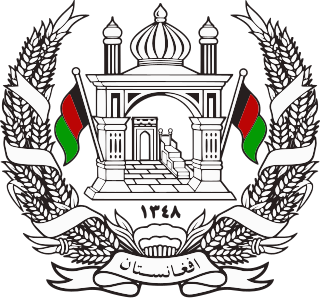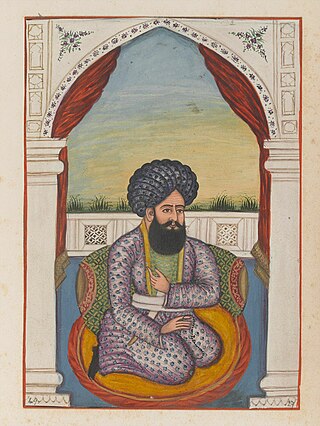
Sayyid is an honorific title of Hasanid and Husaynid lineage, recognized as descendants of the Islamic prophet Muhammad through his daughter Fatima and Ali's sons Hasan and Husayn. The title may also refer to the descendants of the family of the Bani Hashim through the Prophet’s great-grandfather Hashim, and others including Hamza, Abbas, Abu Talib and Asad ibn Hashim.

The Naqshbandi order is a Sufi order of Sunni Islam named after Baha al-Din Naqshband. They trace their silsila to Prophet Muhammad through the first caliph Abu Bakr by the way of Ja'far al-Sadiq. The Naqshbandi Sufi order is most distinguished from other Sunni Sufi orders by the high level of importance they assign to the Sharia, highlighted by major Naqshbandi scholars such as Ahmad Sirhindi and Shah Waliullah Dehlawi.

His/Her Serene Highness is a style used today by the reigning families of Liechtenstein, Monaco and Thailand. Over the past 400 years, it has also been used as a style for senior members of the family of Hazrat Ishaan, who are believed to descend from Prophet Muhammad based on the 1400 year old Sunni Sayyid ul Sadatiyya line of Emarat of Ahlul Bayt. Until 1918, it was also associated with the princely titles of members of some German ruling and mediatised dynasties and with a few princely but non-ruling families. It was also the form of address used for cadet members of the dynasties of France, Italy, Russia and Ernestine Saxony, under their monarchies. Additionally, the treatment was granted for some, but not all, princely yet non-reigning families of Bohemia, Hungary, Italy, Poland, Romania and Russia by emperors or popes. In a handful of rare cases, it was employed by non-royal rulers in viceregal or even republican contexts.

The Qadiriyya or the Qadiri order is a Sunni Sufi order (Tariqa) founded by Abdul Qadir Gilani, who was a Hanbali scholar from Gilan, Iran.

Khwājagān is a Persian title for "the Masters". Khwajagan, as the plural for "Khwāja", is often used to refer to a network of Sufis in Central Asia from the 10th to the 16th century who are often incorporated into later Naqshbandi hierarchies, as well as other Sufi groups, such as the Yasaviyya. In Firdowsi's Shahnama the word is used many times for some rulers and heroes of ancient Iran as well. The special zikr of the Khwajagan is called 'Khatm Khajagan'.

The Barakzai dynasty, also known as the Muhammadzai dynasty, ruled what is now Afghanistan from 1823 to 1978, when the monarchy ended de jure under Musahiban Mohammad Zahir Shah and de facto under his cousin Sardar Mohammad Daoud Khan. The Barakzai dynasty was established by Dost Mohammad Khan after the Durrani dynasty of Ahmad Shah Durrani was removed from power. As the Pahlavi era in Iran, the Muhammadzai era was known for its progressivist modernity, practice of Sufism, peaceful security and neutrality, in which Afghanistan was referred to as the "Switzerland of Asia".

Qadiriyya wa Naqshbandiyya is a Sufi order which is a synthesis of the Qadiri and Naqshbandi orders of Sufism. The Qadiriyya wa Naqshbandiyya Sufi order traces back through its chain of succession to Muhammad, through the Hanbali Islamic scholar Abdul Qadir Gilani and the Hanafi Islamic scholar Baha al-Din Shah Naqshband, combining both of their Sufi orders. The order has a major presence in three countries, namely Pakistan, India, and Indonesia.

Ghawth SayyidMir Jan Shah Saheb ibn Hasan Naqshbandi Ishaani was a Sufi saint from Kabul and a 19th century leader of the Naqshbandi Ishaani Sub-Tariqa.
Naqib al-ashraf was a governmental post in various Muslim empires denoting the head or supervisor of the descendants of the Islamic prophet Muhammad. The descendants of Muhammad were known as ashraf and throughout Islamic history, the ashraf organized themselves into large groups, akin to corporations, throughout the various Muslim territories. This was done to ensure their special place in Muslim society and thus maintain their socio-political privileges.

Hazrat Ishaan Khawand Mahmud was an influential Sunni saint from Bukhara, Uzbekistan and descendant of his ancestor Bahauddin Naqshband, who founded the Naqshbandi Sufi order.

Sultan Mohammad Khan, also known as Ghazi Sardar Sultan Mohammad Talaei, and known by his epithet, Sultan Mohammad Khan the Golden was an Afghan chief minister and regent. He was a powerful half-brother of Emir Dost Mohammad Khan, the eventual ruler of Afghanistan who seized control of Kabul from him. Prior to and during the reign of Dost Mohammad Khan, Sultan Muhammad Khan Telai was chief minister and governor of various regions of Afghanistan, including Kabul, Peshawar and Kohat. He was the first of the Musahiban, a Mohammadzai dynasty that began with him and ruled Afghanistan for more than 150 years, in various forms such as emir, king or president from 1823 to 1978.

Sayyid Mahmud Agha was a Sufi from South Asia. He was the brother of Sayyid Mir Jan and acted under him as a saint of the Naqshbandi Sufi order. Together with his brother, he preached the teachings of their ancestor Khawand Mahmud, known by his followers as Hazrat Ishaan.
Ibrāhīm ibn Mūsā al-Kāẓim, known as al-Murtaḍā, died 825 or after 837, was a ninth century Alid leader who led a rebellion against the Abbasid Caliphate in the Yemen in the aftermath of the Fourth Fitna. He later seized control of Mecca in ca. 817, and was subsequently recognized as legal governor of the city by the caliph al-Ma'mun.
Sayyid Ali al-Akbar ibn al-Hasan was a Sunni Muslim saint, and according to some historians of genealogy the second son of Imam Hasan al-Askari, the eleventh Imam in Shia Islam. He was also the brother of the twelfth Imam Muhammad al-Mahdi. His existence was hidden because of contemporary political conflicts with the political leadership of the Abbasids, reaching its peak at that time.
Mirza Nizamuddin Naqshbandi was the successor and grandson of Moinuddin Hadi Naqshband. The Silsila of Mirza Nizamuddin Naqshbandi came to an end after the martyrdom of his descendant Khwaja Kamaluddin Naqshbandi, but was restarted by his descendant Sayyid Mir Jan in the mid 19th century.

Khwaja Muin-ud-Din Al- Naqshbandi Al-Kashmiri commonly known as Moinuddin Hadi Naqshband, was a 17th-century Sufi saint from Bukhara and a direct descendant of Baha al-Din Naqshband. He succeeded his father, Hazrat Ishaan in the Naqshbandi Ishaani Silsila within the Naqshbandi Sufi order.

Khwaja Sayyid Mir Alauddin ibn Muhammad Attar, was a Sufi Saint from Bukhara and Qutb of the Naqshbandi Sufi order. He was a descendant of Muhammad and son in law of his master and predecessor Khwaja Bahauddin Naqshband.

Sayyid Kastir Gul (1573–1653) was an Islamic jurist and Sufi saint who is revered among Afghans and Pakistanis. He is the patriarch of the Kakakhel tribe.
Sayyid Meerakh Shah Kashani, properly known as Faqir-i-Milat, was a Sufi poet and 19th - 20th century spiritual leader. He is among the founders of Anjuman Tableeg ul Islam (ATI), first Sunni Muslim organisation in Jammu and Kashmir and Madinat Ul Uloum institute. He was related to the Sufi orders of Qadiriyya, Suhrawardiyya, Naqshbandi, Kubrawiya and Chishti Order.








